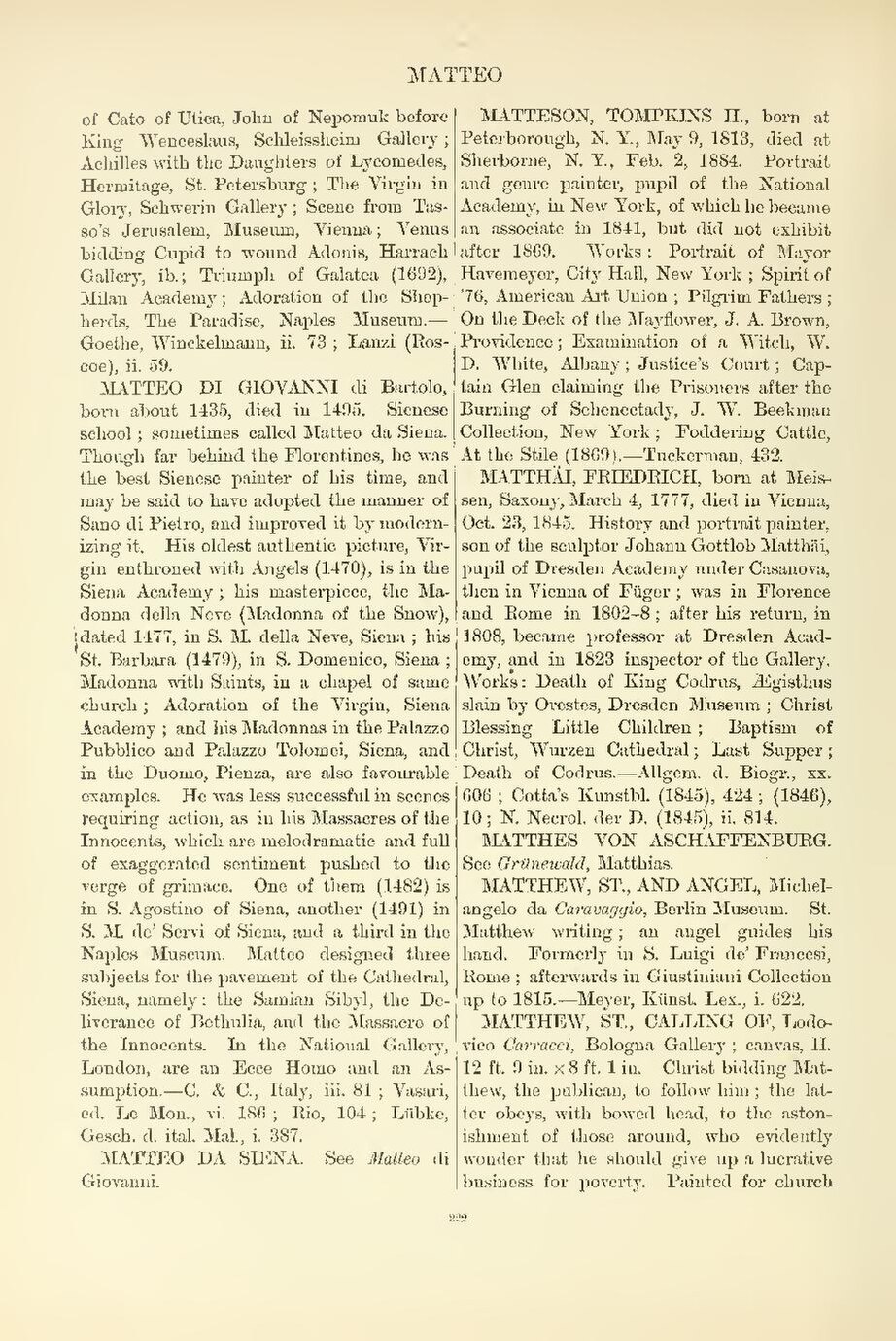of Cato of Utica, John of Nepomuk before King Wenceslaus, Schleissheim Gallery; Achilles with the Daughters of Lycomedes, Hermitage, St. Petersburg; The Virgin in Glory, Schwerin Gallery; Scene from Tasso's Jerusalem, Museum, Vienna; Venus bidding Cupid to wound Adonis, Harrach Gallery, ib.; Triumph of Galatea (1692), Milan Academy; Adoration of the Shepherds, The Paradise, Naples Museum.—Goethe, Winckelmann, ii. 73; Lanzi (Roscoe), ii. 59.
MATTEO DI GIOVANNI di Bartolo,
born about 1435, died in 1495. Sienese
school; sometimes called Matteo da Siena.
Though far behind the Florentines, he was
the best Sienese painter of his time, and
may be said to have adopted the manner of
Sano di Pietro, and improved it by modernizing
it. His oldest authentic picture, Virgin
enthroned with Angels (1470), is in the
Siena Academy; his masterpiece, the Madonna
della Neve (Madonna of the Snow),
dated 1477, in S. M. della Neve, Siena; his
St. Barbara (1479), in S. Domenico, Siena;
Madonna with Saints, in a chapel of same
church; Adoration of the Virgin, Siena
Academy; and his Madonnas in the Palazzo
Pubblico and Palazzo Tolomei, Siena, and
in the Duomo, Pienza, are also favourable
examples. He was less successful in scenes
requiring action, as in his Massacres of the
Innocents, which are melodramatic and full
of exaggerated sentiment pushed to the
verge of grimace. One of them (1482) is
in S. Agostino of Siena, another (1491) in
S. M. de' Servi of Siena, and a third in the
Naples Museum. Matteo designed three
subjects for the pavement of the Cathedral,
Siena, namely: the Samian Sibyl, the Deliverance
of Bethulia, and the Massacre of
the Innocents. In the National Gallery,
London, are an Ecce Homo and an Assumption.—C.
& C., Italy, iii. 81; Vasari,
ed. Le Mon., vi. 186; Rio, 104; Lübke,
Gesch. d. ital. Mal., i. 387.
MATTEO DA SIENA. See Matteo di
Giovanni.
MATTESON, TOMPKINS H., born at
Peterborough, N. Y., May 9, 1813, died at
Sherborne, N. Y., Feb. 2, 1884. Portrait
and genre painter, pupil of the National
Academy, in New York, of which he became
an associate in 1841, but did not exhibit
after 1869. Works: Portrait of Mayor
Havemeyer, City Hall, New York; Spirit of
'76, American Art Union; Pilgrim Fathers;
On the Deck of the Mayflower, J. A. Brown,
Providence; Examination of a Witch, W.
D. White, Albany; Justice's Court; Captain
Glen claiming the Prisoners after the
Burning of Schenectady, J. W. Beekman
Collection, New York; Foddering Cattle,
At the Stile (1869).—Tuckerman, 432.
MATTHÄI, FRIEDRICH, born at Meissen,
Saxony, March 4, 1777, died in Vienna,
Oct. 23, 1845. History and portrait painter,
son of the sculptor Johann Gottlob Matthäi,
pupil of Dresden Academy under Casanova,
then in Vienna of Füger; was in Florence
and Rome in 1802-8; after his return, in
1808, became professor at Dresden Academy,
and in 1823 inspector of the Gallery.
Works: Death of King Codrus, Ægisthus
slain by Orestes, Dresden Museum; Christ
Blessing Little Children; Baptism of
Christ, Wurzen Cathedral; Last Supper;
Death of Codrus.—Allgem. d. Biogr., xx.
606; Cotta's Kunstbl. (1845), 424; (1846),
10; N. Necrol. der D. (1845), ii. 814.
MATTHES VON ASCHAFFENBURG.
See Grünewald, Matthias.
MATTHEW, ST., AND ANGEL, Michelangelo
da Caravaggio, Berlin Museum. St.
Matthew writing; an angel guides his
hand. Formerly in S. Luigi de' Francesi,
Rome; afterwards in Giustiniani Collection
up to 1815.—Meyer, Künst. Lex., i. 622.
MATTHEW, ST., CALLING OF, Lodovico
Carracci, Bologna Gallery; canvas, H.
12 ft. 9 in. × 8 ft. 1 in. Christ bidding Matthew,
the publican, to follow him; the latter
obeys, with bowed head, to the astonishment
of those around, who evidently
wonder that he should give up a lucrative
business for poverty. Painted for church
